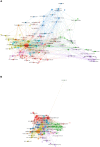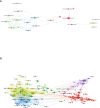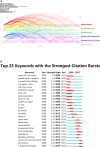Global research trends on precision cancer medicine-related rashes (2008-2021): A bibliographic study
- PMID: 36091077
- PMCID: PMC9458849
- DOI: 10.3389/fimmu.2022.1002034
Global research trends on precision cancer medicine-related rashes (2008-2021): A bibliographic study
Abstract
Background: Precision cancer medicine-related rashes are a kind of skin and mucous lesions caused by precision therapy. More and more evidences indicated that such events should not be ignored in the course of anti-tumor therapy. Since cancer treatment entered the "Precision Era", there has been a rapid increase in this field. However, there was few bibliometric studies to provide an overall review of this field. This study aims to evaluate the literature output and trends in researches on precision cancer medicine-related rashes from a global perspective.
Methods: Collected publications on precision cancer medicine-related rashes from the Web of Science Core Collection database, which were limited to articles and reviews in English. Microsoft Excel, VOS viewer and CiteSpace V were used for quantitative and visual analysis.
Results: A total of 1,229 papers were identified. From 2008 to 2021, annual publications increased year by year. The United States published the most papers in this field (44.9%) and ranking first in citation frequency (19,854 times) and H-index (69). The University of Texas system ranks first with 98 papers published. Lacouture M.E and Robert C were the principal investigators. Cancers has the largest number of articles published, with 70 articles. In recent years, there have been research hotspots related to immunotherapy, including ipilimumab, immunotherapy, tumor microenvironment, association, checkpoint inhibitor, and cutaneous adverse event.
Conclusion: Precision cancer medicine-related rashes are a hot research topic in oncology. The number of relevant publications will increase dramatically. "Checkpoint inhibitors", "skin adverse events", "associations" and "tumor microenvironment" may become research hotspots in the future.
Keywords: bibliometric analysis; checkpoint inhibitors; precision cancer medicine; rash; targeted therapy.
Copyright © 2022 Zhao, Yu, Chen, Zhao, Sun, Xu, Zhang, Dai, Zhang and Shu.
Conflict of interest statement
The authors declare that the research was conducted in the absence of any commercial or financial relationships that could be construed as a potential conflict of interest.
Figures









Similar articles
-
Current status and future of cancer vaccines: A bibliographic study.Heliyon. 2024 Jan 11;10(2):e24404. doi: 10.1016/j.heliyon.2024.e24404. eCollection 2024 Jan 30. Heliyon. 2024. PMID: 38293405 Free PMC article.
-
Knowledge mapping of targeted immunotherapy for myasthenia gravis from 1998 to 2022: A bibliometric analysis.Front Immunol. 2022 Sep 29;13:998217. doi: 10.3389/fimmu.2022.998217. eCollection 2022. Front Immunol. 2022. PMID: 36248874 Free PMC article.
-
Global Trends and Hotspots in Esketamine Research: A Bibliometric Analysis of Past and Estimation of Future Trends.Drug Des Devel Ther. 2022 Apr 21;16:1131-1142. doi: 10.2147/DDDT.S356284. eCollection 2022. Drug Des Devel Ther. 2022. PMID: 35478936 Free PMC article. Review.
-
Research hot spots and trends in endocrine-related adverse events caused by immune checkpoint inhibitors: a bibliometric analysis and visualization research.Front Endocrinol (Lausanne). 2024 Apr 15;15:1253832. doi: 10.3389/fendo.2024.1253832. eCollection 2024. Front Endocrinol (Lausanne). 2024. PMID: 38686201 Free PMC article.
-
Immunotherapy improves disease prognosis by affecting the tumor microenvironment: A bibliometric study.Front Immunol. 2022 Oct 6;13:967076. doi: 10.3389/fimmu.2022.967076. eCollection 2022. Front Immunol. 2022. PMID: 36275770 Free PMC article. Review.
Cited by
-
Insight into the research frontier of hypoxia in skin health and diseases: a bibliometric analysis.Ann Med Surg (Lond). 2025 May 29;87(8):4949-4962. doi: 10.1097/MS9.0000000000003303. eCollection 2025 Aug. Ann Med Surg (Lond). 2025. PMID: 40787562 Free PMC article. Review.
-
Global trends and hotspots in research of robotic surgery in oncology: A bibliometric and visual analysis from 2002 to 2021.Front Oncol. 2022 Nov 11;12:1055118. doi: 10.3389/fonc.2022.1055118. eCollection 2022. Front Oncol. 2022. PMID: 36439475 Free PMC article.
-
Global research trends in precision-targeted therapies for systemic lupus erythematosus (2003-2023): A bibliographic study.Heliyon. 2024 Jun 20;10(13):e33350. doi: 10.1016/j.heliyon.2024.e33350. eCollection 2024 Jul 15. Heliyon. 2024. PMID: 39050478 Free PMC article.
-
Spotlight on macrophage pyroptosis: A bibliometric and visual analysis from 2001 to 2023.Heliyon. 2024 May 23;10(11):e31819. doi: 10.1016/j.heliyon.2024.e31819. eCollection 2024 Jun 15. Heliyon. 2024. PMID: 38845992 Free PMC article.
References
-
- Borghaei H, Gettinger S, Vokes EE, Chow LQM, Burgio MA, de Castro Carpeno J, et al. . Five-year outcomes from the randomized, phase III trials CheckMate 017 and 057: Nivolumab versus docetaxel in previously treated non-Small-Cell lung cancer. J Clin Oncol: Off J Am Soc Clin Oncol (2021) 39(7):723–33. doi: 10.1200/jco.20.01605 - DOI - PMC - PubMed
Publication types
MeSH terms
LinkOut - more resources
Full Text Sources
Medical

